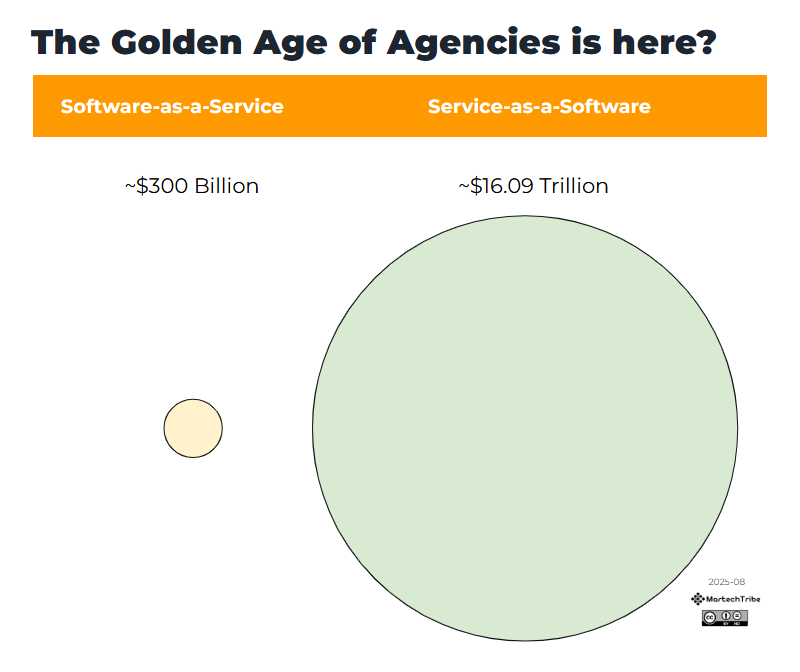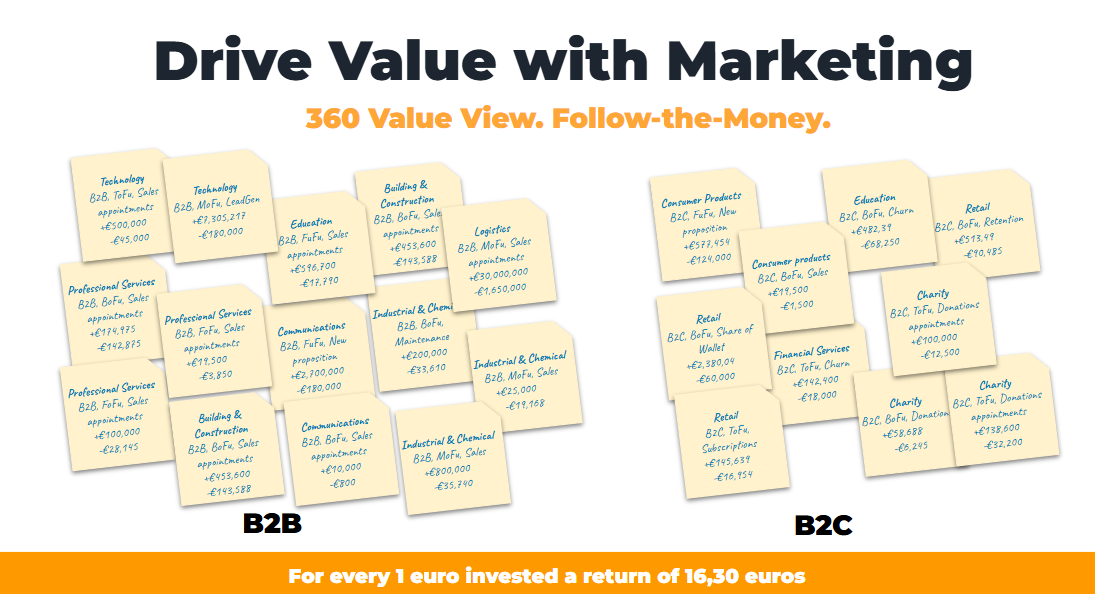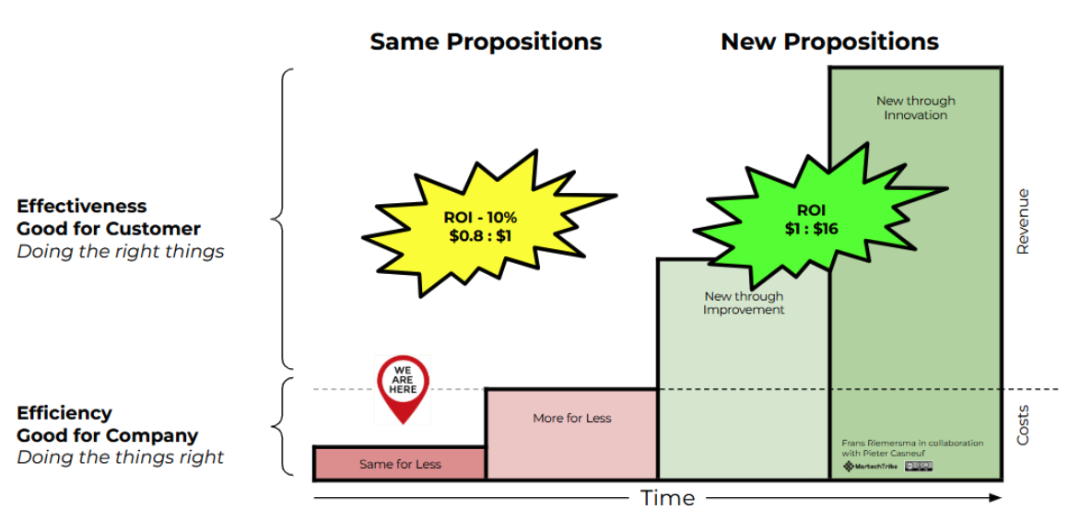
The days of Enterprise suites as we know it are counted. Enterprise suites are out. MarTech platforms are in. It is time to finally abandon the idea that one Enterprise suite should (or even could) cover all areas of marketing, let alone the entire business.
The new trend is one of a technology ecosystem of many tools that are organically adopted and experimentally adapted by the team, a.k.a. democratized martech. The trend is still modest, yet it will soon become a fundamental game-changer. It enables decentralized tooling and centralized insights.

To briefly set the stage, here is an anecdote for you.
“Back in the days of the Cold War, a Russian official visited London. He wanted to know who was in charge of the bread distribution. He could not believe what he learned: there was no overarching central plan, it was spontaneously ordered and working just fine.” The rest is history.
The fundamental misunderstanding about Enterprise suites
The main reason why managers still adhere to the ‘one system fits all’ Entreprise suite religion is the fundamental belief that in order to steer, manage and monitor the marketing department all data should be stored into one system. My experience in dozens of marketing enterprise software implementations in the past decade gave me some painful and fundamental insights and what is more: proof of the opposite.
It is all based on a fundamental misunderstanding between managers and teams. As a result of that misunderstanding we have been trying to use software to hammer a screw into a wall or to measure our weight with a thermometer.
The misunderstanding roots in the fact that managers need to be accountable. Totally legitimate. So far so good. The reason for implementing an enterprise software that I heard most was: ‘As a manager I want to know what my people do and know if we are on track.’ Some added they wanted ‘one mouse click’ to get the status insight.
Yet, the data from their teams does not tell them where they are, or even everything the team is working on. To replace the coffee corner-updates, software is brought into place. So far still all good. But here it comes. What type of software should we pick? What the managers want or what the department need?
This is where the HSW-syndrome kicks in. HSW stands for the Highest-Salary-Wins. Since the managers are the budget owners and have the highest salary in the software discussions, they call the shots. From there it all goes pear-shaped. They go instinctively for the ‘one system fits all’ Enterprise suite.
Why? This will not sound unfamiliar to you. It is not unlikely a consultant told the manager that enterprise software is the best since it puts all the data into one container as the breadth of modules allow the company to expand and scale while keeping the data in that same container while getting rid of the siloes. The magic words are here: ‘fully-fledged, seamlessly-integrated software breaks down the silos’.
Makes total sense, right? No, not at all.
This is what we got wrong over and over again.
Manager Myth one: “Enterprise software provides insight across the business functions”
This idea is based on the premise that companies implement (most of) the modules in the enterprise suite. But that rarely happens.
Over the years I have spoken to many CEOs of such enterprise software and asked a daring question: ‘How many of your clients have bought, implemented and used all of the modules in your suite?’. A painful silence was often followed by a timid grin. ‘Honestly, perhaps 2 or 3 out of the 13 we offer’. Well, there goes your fully-fledged, seamlessly-integrated enterprise idea. The software may be fully fledged in theory, but implementations in practice almost never are.
After some years I added a second question as I felt I hadn’t gotten to the bottom of it quite yet. ‘Expressed in percentages, how much functionality do your clients use per module?’. Another silence and grin: ‘Perhaps 30% of each module’.
Do not get me wrong: 30% is not bad per se. In one project I found that 2 buttons made a difference on 1,2 million euros on a yearly basis. That is not what I am getting at. What I am getting at is that we apparently can do with much less features to get (the same or even more) value for money!
And that is exactly the reason why the new Martech tools are emerging so rapidly and spreading so fast! They do one business task really well. The intuitiveness is way better than the ‘spreadsheet on steroids’ type of software suites. It is resembling that of consumers apps on your smartphone.
So if only a small part of an enterprise suite has been implemented, this argument of getting a single view goes out the window. Agree?
Ok, next.
Manager Myth two: “If every team has their own tool it is not going to work”
Sounds reasonable, but wrong again. It actually does work.
Back in the days I was responsible for consolidating 8 Marketing Asset systems for a Silicon Valley technology provider in the EMEA region. The idea was that marketing cannot operate if you do not know if you have the right and approved version of a marketing asset. The ‘one version of the truth’-idea. I get that. So far so good.
What worked out wrong was the idea to put all marketing assets into one tool across all 27 EMEA countries.
The day we launched the new Marketing Asset platform, we learned there were two new ones launched in the region. Bummer. They ‘illegally’ financed it with campaign budget, which shows how badly they wanted their own tool. After an anger attack, it dawned on me: ‘teams want to choose and use their own tooling’. And if we compared the user adoption levels of the tools, theirs were much better than ours!
This led me to believe: If people hand pick their own tool, adoption is practically guaranteed! And don’t we all know that adoption is the achilles heel of enterprise suites? I have been involved in countless expensive implementations where we were relieved that, after 6-9 months of politics, trainings and ‘pizza ordering’ delays, we made it to the finish line of the project: the go-live of the system.
But there was no life after go-live. We hardly made it to fully adopting the system, let alone reaping the insights from it! And wasn’t that the reason we did choose the enterprise suite in the first place?
So here we are, we implement on average 3 of the 13 entreprise modules, use some 30% of the functionality and have a measly 20%-40% of the team members reluctantly using it. If you multiply those numbers this is how well we do.
(Modules: 3/13) * (Functionality: 30%) * (Adoption: 20%-40%) = Between 2.7% and 1.4% of enterprise suite used. How do you like them apples?
Managers are pretty far off creating the single-view, cross-silo, fully fledged system they set out to create.
Manager Myth three: “Only suites can deliver an integrated view”
‘But Frans, surely letting every team choose their own tooling will not bring the integrated data and insights we need. And if so, it will cost a fortune of time and money to create the necessary APIs (Application Programming Interface) and integrations between tools’.
Wrong again!
The big secret of the new lean & mean Martech tools is actually integration. More than once, I have experienced two completely foreign tools integrate better than two modules of some of the big entreprise suite (please, don’t dare me). On average, marketing departments make use of 32.4 marketing tools. Integration is imperative to make the customer data and work flow.
In fact I have built stacks with freemium tools that approached easily 80%-90% of the functionality of the enterprise software. No lengthy implementation cycles. No politics. No inhumane trainings. No adoption problems. Not even higher cost. In fact, very often x times lower license fees. And above all: Great insights in no time.
Integration is king. It is the trend. So much so, that even a new breed of tools is emerging since 2011. It is called iPaas, integration Platform as a Service. These iPaas tools perform no business tasks whatsoever. They only integrate other tools in a very intuitive fashion. To put it simple: drag and drop APIs.
Recently, Salesforce bought integration tool Mulesoft for 21 times the revenue. That is unheard of! Usually, it’s only about 3-10 times more for software companies. Clearly, integration tools are booming.
Here is a list of iPaas tools. And their popularity is on the rise. The only thing that is keeping them from taking over the market is time and awareness. Spread the word, please.

All well, but how will this change the way we run our business today?
Here are my 5 cents.
As a manager, here is what you should do
Experiment! Allow your people to try, test and pick tools to get their job done. Just make sure of three things.
- They need to know and deliver the data points that are critical to populate the report that shows accountability to management.
- They need to make sure they check the Native Integrations or iPaas tools to let the data flow into other tools in your stack.
- Give the team (official) time & budget to experiment with tools. It will pay back multiple times.
The shift from enterprise suites to Martech stacks is fundamental. Martech stacks give marketers the flexibility to change tools when required, maybe even per campaign. Some best practises for stacks will emerge, and they will be shared among companies. This will encourage SaaS tool developers to improve their products even further. All for the greater benefit of marketing, of course.
As a software vendor, here is what you should do
As a Martech vendor do not attempt to become an enterprise suite. The concept is fundamentally flawed. Build a platform that allows for drag and drop integrations that make business sense instead. Check out our Martech research and interactive cloud to find which tool to integrate next.
As an enterprise suite vendor, start approaching your modules and acquired tools as individual tools with their own native integrations and P&L. Search for the smallest common denominator features, or ‘Jobs to be done’. Kill your darlings and try to trim the remaining tools down to human proportions. Less is more. Users have no time to find out how your tool works. It needs to be self-explanatory. This will allow you to stay competitive with the upcoming flood of legacy-free Martech tools.
As a consultancy, here is what you should do
Stop using Gantt charts, lengthy PRINCE2 projects and Big Bang approaches all together. It is not human. It assumes you can look beyond the three month horizon. There are simply too many parameters in the equation of (business) life to predict how the world will look like in three months from now. It does not make you look incompetent if you stop pretending you can.
Instead, start using Agile Marketing. Even if you have to go into a RFP process, experiment. This helps to ‘gather requirements by doing’. Offer short iterations to make quick improvements that immediately serve the teams. The past three years I have experimented with two week projects, which I call Martech Sprints. It helps to quickly find the right tools through vendor comparisons, find the right 30% of functionality that brings real company value and integrations.
In essence, every move we make has a direct impact. Not just a couple of times per year, but constantly, week after week.
“It feels like Christmas every week”, a client confessed to me.
Ever wanted to experience that feeling yourself? Now you know how to get there.




